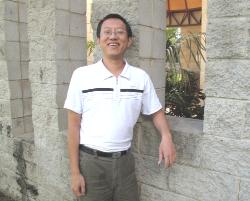A multi-robot system could have helped during Rocky's recent gas leak
Published on 26 May, 2010
Emergency services seeking the source of a gas leak in Rockhampton recently (May 24) could have benefited from a multi-robot system.
That's according to CQUniversity doctoral researcher Qiang Lu, who is looking into how robots could share information for ‘odour-source' investigations.

CQUniversity doctoral researcher Qiang Lu
Qiang says if it was not for wind influencing movement of odour molecules, it would be feasible to locate the odour source by calculating the concentration difference between high and low points of detection.
"In the environment dominated by turbulence, the plume will be highly discontinuous and intermittent," he says.
"In the last two decades, odour source localization problems have received much attention from researchers and engineers due to their practical significance for human security, such as searching for the sources of toxic gas leaks, locating the origins of a fire at its initial stage and rescuing victims.
"Recently, using multi-robot systems to deal with odour source localization problems has received increasing interest. A main advantage of using multi-robot systems is that each robot can share information obtained from other robots via communication networks. Hence, how to share information among robots is a research focus, which is the main motivation of our current research. "
Qiang says that nature shows examples of creatures which use their olfactory sense to detect and react to information in their environment.
"For instance, lobsters have a pair of ‘nose', which is located on each of their lateral antenna. In the light of the odour information detected by ‘noses', lobsters can locate the food source at distances greater than 30cm. Another example is moths, which can make use of wind direction and odour concentration to search for their mates at distances greater than 10m.
"Odour source localization problems originate from the behaviours of such biological entities and presents different characteristics under different environments."
Qiang arrived from China about 18 months ago to start his doctoral research preparations. He comes from the city of Hangzhou near Shanghai.

